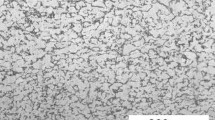Abstract
The role of alloying elements in the dissolution of aluminium sacrificial anodes was investigated. The effect of indium on the electrochemical performance of anode and the relationship between indium and impurities, such as silicon and iron, were studied. The distribution of indium in aluminium alloy was detected. The electrochemical behaviour of In-implanted aluminium alloy was also studied. The experimental results indicate that indium activates the surface of aluminium alloy and improves the electrochemical performance of alloy containing more amounts of impurity. Indium combines with silicon and iron. More satisfactory properties were obtained when the alloy's proportion of content of In to that of (Si+Fe) is about 1∶(8∼10). The electrochemical properties of Al alloy, especially the surface activity of the anode were improved by ion implantation. Indium segregates in the alloy. The amount of Si and Fe in the In-rich segregated phase is richer than that in the matrix. It is proposed that the In-rich segregated phase particles activate the surface and promote the dissolution process of the aluminium sacrificial anode.
Similar content being viewed by others
References
Al-Saffer, A. H., V. Ashworth and W. A. Grant, et al., 1978. The role of mercury in the dissolution of aluminium sacrificial anodes—A study using ion implantation.Corrosion Science 18: 687.
Bossone, Jorge, B., Rafael A. Suarez Baldo, Stella, and M. De Micheli, 1981. Sea water testing of Al-Zn, Al-Zn-Sn and Al-Zn-In sacrificial anodes.Corrosion 37 (9): 533.
Lennox, T.J., R.E. Groover and M.H. Reterson, 1971. Electrochemical characteristics of six aluminium galvanic anode alloys in the sea.Material Protection and Performance 10 (10): 35.
Ninety-seventh Committee of Society of Science Development of Japan, 1970. Test of sacrificial anode and its explanation.Corrosion Engineering 19 (4): 20 (in Japanese).
Reboul, M.C. and Delatte, 1980. Activation mechanism for sacrificial Al-Zn-Hg anodes.Materials Performance 19 (5): 35.
Reding, J.T., 1971, Sacrificial anodes for ocean bottom applications.Materials Protection and Performance 10 (10): 35.
Reding, J.T. and J.J. Newport, 1966. The influence of alloying element on aluminium anodes in sea water.Materials Protection 5 (12): 15.
Sakano, T., K. Toda and M. Hanada, 1966. Test on the effects of indium for high performance aluminium anodes.Materials Protection 5 (12): 45.
Schrieber, C.F. and R.W. Murrary, 1981. Supplementary studies of the galvalum III anode—Hot saline mud and brine environments.Materials Performance 37 (3): 19.
Smith, S.N., J.T. Reding and R.L. Riley, 1978. Development of a broad application saline water aluminium anode—Galvalum III.Materials Performance 17 (3): 32.
Author information
Authors and Affiliations
Rights and permissions
About this article
Cite this article
Hejian, S., Shizhong, H. Zn's role in dissolution of al sacrificial anodes. Chin. J. Ocean. Limnol. 8, 354–362 (1990). https://doi.org/10.1007/BF02849681
Received:
Issue Date:
DOI: https://doi.org/10.1007/BF02849681




